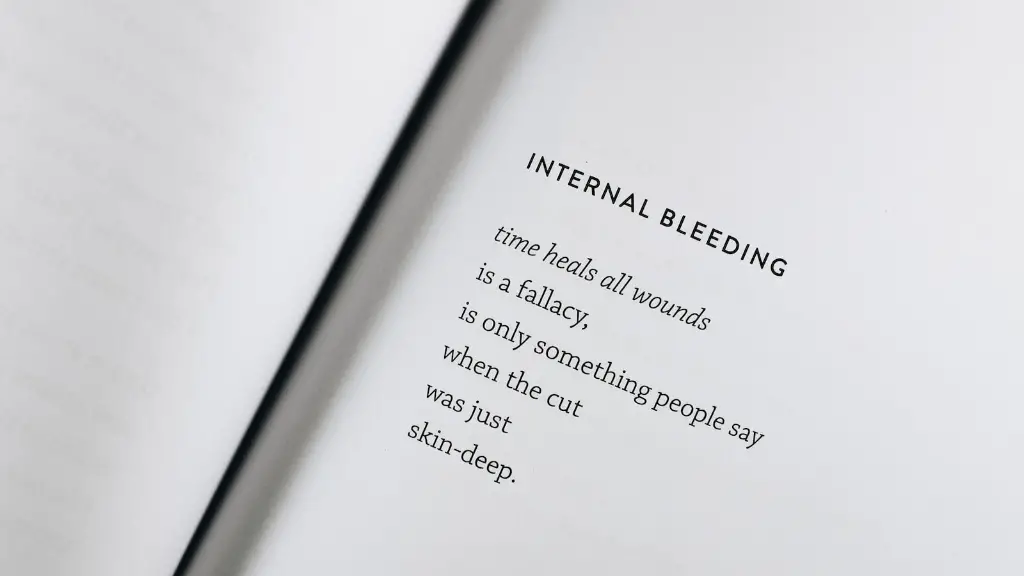Background of the Ghazal
The ghazal is an ancient form of literary expression that dates back to the 7th century, when Persian poets in Iraq and Iran began writing lines of verse that rhymed and shared similar meter. This arrangement of lines inspired later Arabic and Urdu poets who eventually developed ghazals into their own unique style. Each line in a ghazal stands independently as a poetic unit and the entire poem itself is composed of a minimum of five and a maximum of fifteen such individual units. A ghazal is characterized by a complex and intricate rhyme scheme, usually involving a couplet at the end of each line, but often allowing a poem to take on a more symmetrical form. The impact of a ghazal comes not so much from the individual lines, but from the overall composition of the poem, as each line is a reflection of the whole.
Main Elements of a Ghazal
A ghazal must contain two main elements in order to be considered a true ghazal. The first requirement is that the individual lines must have a consistent rhythm and share a common end rhyme. This means that the last syllable of each line must rhyme with the corresponding last syllable in the subsequent line. Typically, the rhyme scheme will be aa, bb, cc, dd, etc., but some ghazals may employ a more complex system, such as aa, ba, ca, da, etc.
The second element is that each line must have a certain level of unity. This means that each line of verse must contain a distinct and meaningful idea that echoes in subsequent lines. In traditional ghazals, these ideas will often be related to love, longing, sadness, and passion, and will often include references to the poet’s own feelings or those of another person. This sense of unity helps give the poem a cohesive, lyrical feel and adds to its overall impact.
Thematic Ideas of a Ghazal
Although the primary characteristic of a ghazal is its form, its content is also important. Ghazals typically deal with themes of love, loss, longing, and emotion, and can often be deeply personal. The poets who create ghazals often draw upon their own experiences to create a poem that expresses both the beauty and pain of existence.
One of the most commonly used themes in Ghazal poetry is the concept of unrestrained love. The classical Ghazal poet would often express his innermost desires to an idealized beloved. By suggesting an unattainable level of unfettered freedom and passion, the poet seeks to create an atmosphere of intense emotion. This is often achieved through the use of metaphor, allegory, and evasion, allowing the poet to hint at both his own feelings and those of the object of his affections.
Style of the Ghazal
Ghazals often explore the boundaries between melancholy and joy, utilizing a poetic style that blends direct expression with lyricism. Ghazals often employ metaphors, symbols, and allusions in order to convey their ideas, and are well-known for their use of vivid imagery. As a result, a ghazal can often evoke powerful emotions in the reader.
Because of its complicated structure, the ghazal is often thought of as being difficult to understand. However, the structure of the poem is actually intended to make the poem’s complex ideas easier to comprehend. By providing a consistent rhythm, the reader is able to more easily follow the flow of sentiments within the poem.
The Refrain of the Ghazal
One of the most important elements of a ghazal is the refrain, a line or phrase that is repeated throughout the poem. The refrain provides a sense of continuity, while simultaneously allowing the poet to explore various themes and ideas. The refrain also serves to link the individual lines together, creating a more unified whole.
The choice of refrain is often a reflection of the poet’s own inner feelings or the sentiment of the object of his or her affections. By employing the refrain in each line, the poet is able to add an additional layer of emotion to the poem, creating an atmosphere of both beauty and pain.
The Significance of the Ghazal
Over the centuries, the ghazal has become an important literary form in the Middle East, India, and Pakistan. It has also become admired by many Western writers and poets who, as a result, have begun to create their own versions of the form.
The Ghazal is often seen as a metaphor of life itself. In its interweaving of serious and joyful themes, the poet is able to create a powerful, evocative statement on the human experience. By exploring the tensions between joy and sorrow, hope and despair, the Ghazal helps illuminate the beauty and complexity of the world around us.
The Impact of the Ghazal
The Ghazal has had an extensive impact on poetry and literature throughout the world. Its intricate and evocative style has inspired countless poets, while its universal themes and images have given it a timeless appeal.
Perhaps the most significant contribution of the Ghazal is its ability to capture the essence of emotion. By exploring the nuances between joy and sorrow, and love and loss, the Ghazal gives the reader a unique insight into the human experience.
Expression of the Ghazal
The Ghazal gives the poet a unique opportunity to express personal sentiments and emotions. The individual lines allow the poet to explore both personal and universal ideas, while the refrain serves as a unifying force, creating a sense of continuity throughout the poem. By using vivid imagery and emotional language, the poet is able to create a powerful statement that is both reflective and uplifting.
Moreover, the structure of the Ghazal allows for a flexibility of expression and form that is not found in other forms of verse. This allows the poet to explore a range of topics in a single composition and to experiment with both language and form.
Rhythm of the Ghazal
Ghazals are distinguished by their distinct rhythm and metre. This is achieved by utilizing a quatrain structure and regular meter. As a general rule, the lines of a Ghazal should have eleven sybillables, and must have a consistent rhythm. The quatrain structure helps to create a sense of unity, while the regular meter allows the poet to build tension and convey emotion.
The rhythm of the Ghazal is also an important contributor to its overall impact. By having a consistent rhythm, the poet is able to create a more unified poem and to convey meaning in a more effective way. The regularity of the rhythm also encourages the reader to engage with the poem on a deeper level, allowing them to enjoy the beauty of the language and appreciate the deeper meaning of the poem.
Persistent Nature of the Ghazal
The Ghazal has been a prominent literary form for centuries and its popularity is not likely to diminish anytime soon. Its appeal lies in its ability to capture and express the complexities of human emotion. The vivid imagery and intricate structure of the Ghazal is capable of evoking powerful emotions from its readers, offering a unique insight into the bittersweet embrace of life.
Moreover, by utilizing a distinctive rhythm and metre, the Ghazal creates a powerful unity between the individual lines, allowing the speaker to convey their ideas in an efficient and meaningful way. Thus, the Ghazal is a lasting testament to the power of poetry and its ability to both educate and inspire.


